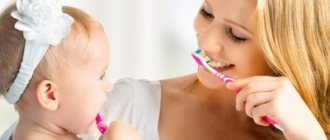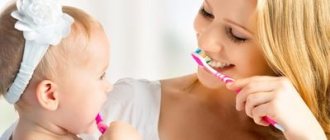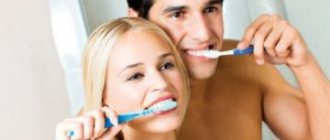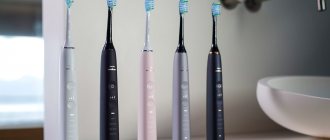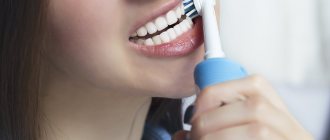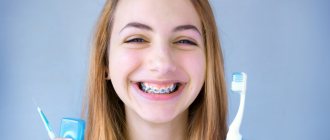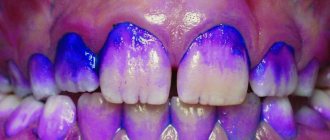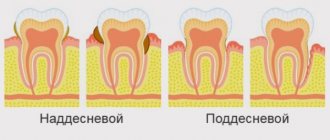Not all parents know how to properly brush their children’s teeth, but the condition of the erupted permanent teeth depends on the quality of care for baby teeth.
. To protect your child from problems with molars, incisors and canines, it is necessary to teach him to brush and rinse his mouth after the very first tooth erupts.
Features of the structure of milk teeth
Baby teeth form in the sixth week of fetal development. Normally there are 20 of them:
- 8 molars;
- 8 incisors;
- 4 fangs.
Temporary teeth consist of the same tissues as permanent teeth:
- dentin (in temporary teeth it is softer and less mineralized);
- enamels;
- pulp.
However, primary incisors, canines and molars have features:
- low crowns;
- large distance between crowns;
- long thin roots that dissolve before the temporary tooth falls out and the permanent tooth erupts;
- thin enamel - only 1 mm;
- wide channels.
The structure of baby teeth is only slightly different from permanent teeth, so they no less need proper care. You can start brushing your child’s teeth after the very first incisor has erupted.
. Early training in hygiene will be an excellent prevention against many dental diseases that can affect the primary incisors, and then the rudiments of the permanent ones formed under them.
If you don’t care for your baby’s teeth or care for them incorrectly, your baby will have to visit pediatric dentists already in the first three years of life. Or he may tolerate drilling rotted teeth with a bur, which is painful and unpleasant for a small child, even with high-quality anesthesia.
A fingertip for cleaning gums and first teeth – a toddler’s first toothbrush
A child’s first toothbrush is usually a finger cap, which is a silicone “cap” with soft silicone bristles that is placed on the mother’s finger.
This brush will not scratch children’s delicate gums, improve blood circulation and provide a gentle massage of the gums.
There are no dangerous components in the fingertips, and caring for them is easy.
The recommended age for using finger pads is 4-10 months. But you shouldn’t get carried away with using this tool during teething.
How to properly clean a baby's mouth
Immediately after being discharged from the hospital, you need to start wiping the newborn baby’s gums with a thick gauze swab dipped in water. You can also wet the tampon in:
- chamomile infusion, if the baby does not have constipation;
- bactericidal infusion of sage;
- St. John's wort decoction, as this plant strengthens the gums;
- anti-inflammatory decoction of calendula.
It is not recommended to use decoctions and infusions of herbs to treat the oral cavity of a baby more than 2-3 times a week, as their abuse can lead to allergic reactions.
Maintaining hygiene, which involves treating the oral mucosa with a gauze swab, is necessary for both newborns who are breastfed and those children who are fed artificial formula. Breast milk does not clean the oral cavity, but pollutes it. If you do not sanitize your baby’s mouth after feeding, then pathogenic bacteria will begin to multiply in it, which can lead to infection of the tooth enamel.
What to focus on?
- For children up to 3 years old. Pastes for this age should not contain fluoride at all.
- For kids 3-4 years old. The fluorine content in pastes should not exceed 200 ppm, and the abrasive content (approx. RDA) should not exceed 20 units. There must be an inscription about the safety of the paste when swallowed (as for any paste “from 0 to 4”).
- For children 4-8 years old. In these pastes, the abrasiveness can reach 50 units, and the fluoride content can reach 500 ppm (but no more!). The paste may have anti-inflammatory properties and contain appropriate herbal ingredients. From the age of 6, you can add dental floss to your toothbrush, which you also need to teach your child to use.
- For children 8-14 years old. These pastes can already contain up to 1400 ppm of fluorine, but no more than 50 ppm of abrasive.
- From the age of 14, children can already use traditional versions of adult toothpaste.
At what age should a child start brushing his teeth?
You need to start brushing your baby's teeth from the moment they begin to erupt.
At first, it is better to perform manipulations without paste, carefully treating not only the first tooth, but also the gum itself. You can use a special soft baby brush or a silicone pad that is placed on the parent’s finger. The last device will serve not only as a brush, but also as a gum massager, which will ease the pain from teething.
You should act carefully during the cleaning process, since the gums near the cutting tooth are inflamed and painful, so infants may react poorly to the hygiene procedure. But you cannot refuse it: during teething, local immunity deteriorates, so the risk of infection of the enamel increases.
More details about caring for the oral cavity of a newborn are described in the video:
This tool will be very useful and effective if...
- The child has already reached 6 years of age.
- The child knows how to rinse his mouth and spit out the contents so as not to swallow any liquid accidentally found in the mouth.
- The rinse aid does not contain harmful components.
- The mouthwash is used for its intended purpose (for caries, for fresh breath, etc.).
- The procedure time does not exceed 30 seconds twice a day.
The site Colady.ru thanks you for your attention to the article! We will be very pleased if you share your feedback and tips in the comments below.
How to properly brush children's teeth
There are several general rules for high-quality teeth cleaning, depending on the age of the baby:
- A child under one year old should brush his teeth using a special silicone pad, which is fixed on the parent’s index or thumb.
- After a year, you can use a brush with silicone bristles and a special limiter, gradually switching to classic models.
- From the age of three, a regular brush with soft bristles is used. It is important that its surface is covered only by two dental crowns, otherwise the hygienic procedure will not be effective enough.
A baby brush needs to be changed every 3-4 months. If the service life has not yet expired, but the brush has already become rough around the edges, you should change it, since pathogenic bacteria can begin to form and multiply between the bristles.
How to brush the teeth of a child under 1 year old
Six months is the age when parents should start brushing their child’s teeth every day.
From 6 to 12 months, children are cutting teeth, so during this period it is necessary to sanitize their oral cavity very carefully. The baby cannot yet take part in the hygiene procedure, but can already express his dissatisfaction with sounds and gestures, so the adult should focus not only on the dental cleaning technique, but also on the baby’s sensations.
How to properly brush your first teeth
Key cleaning rules:
- the necessary movements should be sweeping: from the root to the top;
- the finger with the silicone attachment should be in the child’s mouth at an angle of 45 degrees to the gums;
- when processing chewing surfaces, the finger with the nozzle is positioned horizontally and cleans the crown with progressive longitudinal movements;
- The inner surface of the teeth is cleaned with short, quick movements;
- The side teeth can be cleaned using circular movements.
There should be about 10–15 movements per tooth. During the procedure, it is necessary to clean not only the dental enamel, but also the inner surface of the cheeks, tongue and gums. You can also brush your one-year-old child's teeth using special dental wipes, which can be purchased at the pharmacy.
Why you need to teach your child to brush their teeth earlier than one year
You should start brushing your baby's baby teeth when the first incisor appears or even before it fully erupts. Complete oral care will help:
- form the correct bite;
- It is good to clean the oral cavity from cariogenic bacteria;
- prevent various diseases, including caries.
How to brush teeth for children over one year old
A child over 1 year old can purchase their first toothbrush with silicone bristles. It costs more than a regular one, but such a waste of money is justified: a brush with silicone bristles will not injure the child’s teeth and will help to thoroughly clean the gums and cheeks. You can use it to clean even your child’s first teeth. However, such brushes quickly become unsuitable for safe use, so they should not be used for a long time.
Rules for caring for a children's toothbrush with silicone bristles
In order for the silicone brush to last longer, you must follow the following rules for its operation:
- Do not boil or even simply pour boiling water over the brush;
- After each use, you should wash it with soap (baby, tar, laundry).
The brush should not be placed in a case; it should be stored in a closed cabinet, in a glass, separately from the brushes of adult family members.
Budget segment
Aquafresh My baby teeth
This product is designed for children aged three to five years, that is, they are already quite independent and are able to take care of themselves, including brushing their teeth. Available with bright caps made in the shape of animal heads. The brushes themselves are painted in eye-catching colors and different patterns, so kids will have fun caring for their teeth with these products.
More: TOP 5 best cereals for first feeding
The handle here is very comfortable; it consists almost entirely of rubber inserts, so it will not slip even in wet children’s fingers. There is a suction cup on the base - the brush does not have to be put away in a cup, but can simply be stuck on the wall or on the sink. The bristles here are very soft, made of silicone, and practically do not wear off during use.
Advantages:
- The original protective cap is provided;
- Very carefully cares for children's teeth and gums;
- Attractive appearance;
- The ergonomics of the handle and suction cup are carefully thought out.
Flaws:
- The product quite quickly loses its original appearance;
- Relatively rigid connection between head and handle.
Aquafresh toothbrush My baby teeth
Colgate SpongeBob
The first electric model in our review, powered by standard batteries or traditional AA batteries. Despite its quite reasonable cost, such a brush functions very effectively. It cleans teeth thoroughly and efficiently - removing much more plaque and pathogenic bacteria than a standard toothbrush. This device is equipped with a small vibrating head. Despite the fact that it rotates quite quickly, the enamel remains intact.
The bristles are made of soft rubber, which are at a slight angle to each other. The handle of the device is of high quality, its shape is carefully thought out, so the child can easily use it independently. These products are suitable for children aged 3 years and older.
Advantages:
- Very beautiful and bright design;
- Batteries are included with the toothbrush;
- Reasonable price.
Flaws:
- There is no battery charge indicator;
- There is only one nozzle, and it is not possible to change it if necessary;
- There is no automatic shutdown timer for the device.
Colgate SpongeBob Toothbrush
Bebe comfort
The set comes with two comfortable, interesting and not quite ordinary toothbrushes from a well-known French manufacturer. One product has bristles made of silicone, the other of ordinary materials. It is worth noting that the manufacturer recommends using such products also for teething. The product handle is made of rubberized materials and has an ergonomic shape. Thanks to this solution, the brush will not slip out even from wet hands, so the likelihood of injury to the oral cavity is reduced to almost zero.
The brushes are very ordinary, they do not contain any electrical elements, so they are prepared for use in the simplest way: boiled in water for several minutes. It is worth noting that this brush can be used starting from the age of three months.
Advantages:
- The set includes two easy-to-use brushes, and each of them has a case;
- Convenient and easy to sterilize;
- Can be used for teething;
- Safe and versatile in use.
Flaws:
- The bristles are quite hard.
Bebe confort toothbrush
BABYONO
In second place in this section of our review of the best toothbrushes for children is also a set presented with three accessories at once, each of which will correspond to a certain age of the child. Such a solution from the manufacturer will be a very convenient and practical purchase, since the baby’s parents will no longer have to constantly search for and purchase toothbrushes for a new stage of dental and oral care.
The set includes a special massager suitable for the period when the child is cutting his first teeth. It will also provide complete care for the baby's gums. The silicone brush for the first teeth is made from the safest materials that will not cause an allergic reaction or irritation. The bristles themselves are very soft. The third toothbrush is designed for effective and high-quality oral care in older age. The brushes are made in a variety of colors and are characterized by a comfortable handle.
More: Top 10 best diapers for newborns and the best panty diapers for children
Advantages:
- The set contains the entire set of brushes that will be useful to the baby, starting literally from the moment of birth;
- The products are absolutely safe;
- Very comfortable handle.
Flaws:
- It is not found everywhere, although it is not very expensive.
BABYONO toothbrush
PresiDENT Kids-Junior
This brush is best suited for children aged 5 to 11 years; it is characterized by a very bright design and is intended exclusively for self-cleaning teeth, oral care, and so on. The handle is thick and has soft rubber inserts. On the front side you can find a slope for the thumb, on the back side there are waves for convenient placement of the remaining fingers. The head has a cone shape. The bristles are soft and graduated, made of high quality nylon, and have rounded tips.
The bristles here are divided into two bundles - upper and lower. The first one has small overall dimensions and is blue in color, the second one is larger and painted white. Both of these units are designed to thoroughly remove even the smallest food debris in the interdental spaces, effectively cleaning the back teeth. The weight of the product is only 25 grams with a length of 14.5 cm. A protective cap can also be found in the kit.
Advantages:
- Beautiful appearance that will be maintained throughout its entire service life;
- Carefully but thoroughly cares for teeth, gums and the entire oral cavity;
- Reasonable cost;
- Includes a cap for convenient storage;
- The handle will not slip in your palms.
Flaws:
- Not detected.
Toothbrush PresiDENT Kids-Junior
Toothpastes for one-year-old children and infants
To start brushing children's teeth using toothpaste, it is not necessary to wait until the child is one or three years old. Most toothpastes are indicated for children over 2 years of age, however, there are a number of manufacturers whose product lines include good fluoride-free toothpastes suitable for children under one year of age. They are completely harmless and can be swallowed. Such products can be found among the brands:
- ROCS
- Elmex.
- Splat.
- Lacalut.
Each toothpaste indicates at what age it is approved for use - you need to brush your child’s teeth only with a product that is not contraindicated for him and is suitable for comprehensive care of children’s teeth.
When starting to brush the teeth of a child under one year old using toothpaste, you need to monitor his reaction. Some babies may develop allergies, so at the first symptoms of a rash or an incomprehensible cough, you should stop using the paste and show your baby to a doctor.
So, the main selection criteria:
- High-quality plastic (request a certificate from the seller).
- Rigidity. For your first brush, choose the softest or ultra-soft bristles. Medium hard bristles will be needed from 3 years of age.
- Natural or synthetic? It is highly not recommended to choose a brush with natural bristles for a child - it is much inferior to the synthetic version in terms of wear resistance and the rate of growth of bacteria on the surface. Natural bristles allow bacteria to multiply very quickly, and regular sterilization quickly renders the brush unusable. Among the new products of recent years we can highlight bamboo bristles. Its service life is only 1 year, and without proper drying, fungus quickly forms on the brush. And another option is silicone bristles, but this option is only suitable for periods “to the teeth” and during teething (up to 1 year). Synthetic bristles remain the ideal option.
- Length of bristles. For babies over 1 year old, its length should be about 11 mm. However, you can also choose multi-level bristles with a V-shaped arrangement of synthetic bristles for ideal cleaning of rare teeth with serious gaps.
- Pen. It should have rubber anti-slip inserts and a flexible connection to the head. As for the length, the handle should not be too long, but should still remain optimal for a child’s fist. From 2-5 years, the length of the handle can reach 15 cm.
- Head size. For a one-year-old baby, the size of the brush head should not exceed 15 mm. And to get a more accurate orientation, look into the toddler’s mouth: the length of the brush head should be equal to the length of 2-3 of the baby’s teeth. From 2 years old you can look for a brush with a head of up to 20 mm. The shape of the brush head must be streamlined and smooth (so that there are no corners, burrs or scratches).
- The presence of a rubber brush for the baby's tongue on the back of the brush.
- As for the design , it all depends on the mother and the baby himself. Let him choose the design of the brush himself - then you won’t have to persuade your child to brush his teeth.
Teeth brushing technique with toothpaste
You can start brushing your teeth with toothpaste when the child’s first incisor appears, the deadline is one and a half years.
You shouldn’t wait until he develops caries due to lack of proper care.
Brushing procedure with toothpaste:
- a certain amount of paste is applied to a pre-moistened brush;
- the brush is brought at a right angle to the crowns;
- The tooth surface must be cleaned using sweeping movements: from the roots to the tops;
- The inner dental surface is cleaned with short movements, the brush is placed at an angle of 45 degrees;
- the cutting and chewing surfaces of the crowns are processed at the very end;
- after completing the procedure, you should rinse your mouth with water;
- The approximate duration of each cleaning is 2–3 minutes.
2–3 years old is the age when you need to start teaching your child to brush their teeth on their own.
How electric brushes work
If you compare the efforts made to brush your teeth with a regular brush, which everyone is accustomed to since childhood, and an electric one, then the advantages will undoubtedly be with the latter. After all, the 2-3-5 minutes that you need to spend carefully cleaning all surfaces, corners, spaces and grooves in your teeth, while straining your fingers, sometimes turning your hand in the right direction, can be successfully replaced with a simplified process, spending much more on it less time and effort. And an electric toothbrush will save this time.
The secret is simple: a special motor is built into the body of such a brush, and with its help the bristles are set to a certain speed. In addition, the bristles have the ability to change the direction of their rotation: from circular rotation to up and down movement. It is this ability of the bristles that allows you to more thoroughly clean accumulated dirt, and simply complete cleaning several times faster.
How to teach a child to brush their teeth
Many children under 1 year old, and sometimes older children, do not want to brush their teeth, expressing their dissatisfaction in every possible way. In this case, it is necessary to attract their attention to the hygiene procedure using one of the following methods:
- buy a bright brush with your favorite cartoon character and toothpaste with a pleasant fruity taste;
- invite your child to brush the teeth of his toys;
- brush your teeth with your child and compete with him in the quality and speed of brushing.
Each parent independently decides at what age to start brushing their child’s teeth and whether to use toothpaste, but delay can negatively affect the baby’s health. Parents should not only brush their children’s teeth, but also teach them how to properly care for their mouth on their own.
Dr. Komarovsky talks in more detail about children’s teeth, caring for them and teaching a child to brush:
Types of electric toothbrushes
They are divided into sonic and ultrasonic brushes.
Sonic brushes , based on their name, make a sound when working, since their rotation speed is several tens of thousands of movements per minute. And this allows you to clean your teeth very thoroughly and efficiently. With their help, it is possible to get rid of not only food debris, but also plaque.
The operating principle of ultrasonic brushes is slightly different. The movement of the bristles occurs as a result of special acoustic vibrations, and they produce almost 200 million movements per minute. This type of electric brush is unanimously recognized in the dental world as the safest version.
